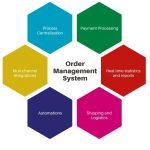For every delivery and eCommerce business having a successful returns management policy is key. If you have a business that sells and ships products, your current return policy plays a major role in flourishing your business as it could be helping you gain or lose customers.
Handling product logistics is already a challenge faced by businesses but if your return policy isn’t efficient you could end up losing customers. Having a returns management policy that has low shipping costs and allows multiple returns, helps businesses retain customers and shows customer loyalty which means an upward revenue stream.
Meaning easy and low-cost returns keep your customers loyal which ultimately leads to an increase in orders and customer satisfaction. Additionally, an organized returns management system ensures that you keep the business impact of returns to a minimum.
What Is Returns Management?
Returns management, also known as reverse logistics, is an important process for businesses and customer relationships in retail and e-commerce. This process involves returning or replacement of a product for any number of reasons.
Returns management is much more than just giving suitable returns options to your customers. Once the returned product has been collected, then depending on the business and situation it must be restocked, organized, recycled, refurbished, or sold for parts.
Returned products mean more shelf space, which leads to a higher holding cost and more labor costs. In addition, the price of the returned products could have depreciated in the market-leading to profit loss.
A company’s return management doesn’t end with consumers having a better shopping experience but also needs to include strategies to quickly recover revenue lost from returned and refunded products.
A return policy should also include what actions to take with customers who return products, such as offering refunds, store credit, product repair, or exchange.
Effective return strategies allow businesses to generate more sales and create a bigger revenue stream.
There are 3 pillars to Returns Management:
The returns management process needs to be hassle-free for customers and cost-effective for businesses. This process demands to have a proper understanding of products and their movement within the supply chain. Three main elements support effective returns management: speed, visibility, and control.
- Speed:
For quick and easy returns management, businesses automate return material authorizations (RMAs), this process affirms the refunds, exchanges, or repairs for returned products. Three further tools are used to speed up the returns process:
- Workflow Automation
Workflow automation refers to collecting data and analyzing it through software rather than manually identifying data. Through
software systems, data reports can be quickly streamlined and RMAs can be validated.
- Labels and Attachments
Through automated workflow shipments will be accurately labeled and printed allowing real-time shipment management. These tools minimize delivery delays as labels are carrier compliant and have the required attachments.
- User Profiles
Inventory software makes user profiles of all the customers and stores important information about their consumers. This simplifies the return management process allowing businesses to track their stocks and waste products. Inventory forecasting tools can utilize this customer data, along with historical sales, to predict future return patterns and optimize stock replenishment, minimizing potential losses.
- Visibility:
To improve visibility in the returns management process product information should be obtained before it is brought to the receiving dock. Three methods ensure visibility during this process:
- Web-Based Portals
Web-based portals are online solutions allowing users to carry out necessary activities regardless of their geolocations and time zones. Through inventory management tools users will be able to access real-time updates and important data information.
- Carrier Integration
Carrier integration connects RMAs with carrier tracking numbers This can be done through software programs that send automated notifications about real-time updates and deliveries.
- Barcode Identifiers
Barcode identifiers provide more visibility about inbound products and shipments. A quick scan of the barcode gives information about the product including its name, current condition, stock levels, and much more. This allows shipment receivers to prepare the staff and supplies needed.
- Control:
Synchronizing inbound and outbound movements of products can be difficult. Due to which businesses need more control over the supply chain process, this can be done through three effective methods:
- Regulatory Compliance
Corporate liability can be minimized by following geographical and industry-specific regulations. Compliance with different regulations will guarantee the proper shipment of inbound and outbound products.
- Reconciliation and Final Disposition
Labeling and data integration makes information about RMAs, product costs, and shipments easily accessible. This helps streamline the software inventory and creates a balance between customer satisfaction and internal financial control.
- Quality Assurance
Regular quality control checks ensure the elimination of any product issues before they can negatively affect the business. Changes to the materials and products are made to reduce future product returns after proper quality control checks.
5 Ways to Improve Your Returns Management Systems
Returns management is a challenge faced by many businesses as it can end up costing you a huge chunk of your profit. However, there are many ways to reduce your eCommerce returns and improve your returns management strategy.
Here are the top 5 ways to improve your Returns Management Systems:
1. Understand Controllable and Uncontrollable Returns
Product returns can end up costing both the business and the customers, making it very important to take all the necessary steps to reduce them. One of these steps includes understanding both the types of returns, controllable and uncontrollable.
- Controllable returns are returns that either be avoided or eliminated through better logistics processes taken by the company. These processes can include checking for wrong or misleading product descriptions, poor packaging, slow delivery services, and bad transportation.
- Uncontrollable returns are returns that sellers generally can’t predict or do anything to prevent. These returns are generally unavoidable, e.g. a buyer purchases it as a present but the gift receiver might not like it or the buyer might have a change of heart and want to return it themselves. These variables cannot be accounted for by the seller therefore these types of returns are termed uncontrollable.
If you understand both types of returns only then can you prevent them through strategic returns management policies.
Controllable returns can be prevented by providing detailed product descriptions with photos, by using different packing materials and different transport methods. Updating your inventory management system can also help reduce controllable returns and if after all of this you still get a high volume of returns then make sure to assess the quality of the products themselves and the manufacturing processes.
For uncontrollable returns, there is no foolproof way to reduce returns but one step that businesses can take to reduce these types of returns is to reduce the time in which a customer can return a certain product. However certain studies show the longer the return window the more time customers have to form an attachment with a certain product making them less likely to return it. But this too is only a theory and ultimately, it’s up to the business to test to determine which option works best for them.
2. Understand the Cost of Returns
Customer satisfaction in q-Commerce is very important for an online business. A good return policy ensures customer loyalty, as customers love businesses that offer free returns. A good returns policy also helps the business itself, therefore it is important to understand how much the returns process is affecting your overall profit. This process would include the cost of return shipping, its tracking, as well as managing returns which would include more labor and storage space.
Keeping a track of these costs can help get insight into what’s best for the business; for example, if the calculations reflect that the cost of returning an item is as much as creating a new one then you should consider issuing the customer a refund and let them keep the original. Offering free returns improves customer satisfaction and increases their loyalty to the seller which in return creates more business.
3. Have a clear return policy
Customer experience is highly dependent on having a clear and easy-to-understand returns policy. Having an easily accessible and understandable returns policy, is as important as your shipping policy, and should be published on your website, any partner sites, and also included with all your shipments. This ensures that the customers fully understand the terms and conditions around returns and refunds, and allows your customer service teams to manage expectations regarding refunds, exchanges, and the relevant deadlines.
Clarity of returns policy and process also directly impacts your operational costs, given that all take-back of goods can be expected to generate operational inefficiencies and additional costs. Significant cost reduction can be achieved through the prevention of returns.
4. Analyze your returns
Understanding the reasoning behind your returns is key to improving the quality of your service and products. Whenever an item is returned, it should be used as an opportunity to improve your understanding of customers, products, and market trends. With the help of an automated software system, you can aggregate customer feedback, and analyze it across several variables such as customer, product, and geographic segments.
Through such analysis, you can identify common factors which might be causing high return levels, and what can be done to fix the underlying issues. More importantly, this analysis allows you to understand customer personas and identify any serial returners who might be misusing the returns policy.
5. Process Q-Commerce returns Quickly
Merchants and q-commerce retailers which hold refunds, or take too long to process returns, face a significant risk of losing loyal customers, as well as receiving negative feedback on social media and online forums. Studies show that most customers would stop shopping with online retailers who don’t process returns/refunds quickly, and they would also give negative feedback to their social circles.
The impact of slower returns on q-commerce retailers’ reputations has continued to increase, as returns and banking processes for most q-commerce retailers have become faster, to meet the expectations of very demanding customers. With support from integrated quick commerce platforms like Blink, speeding up your returns process has become achievable in a short time, providing you the ability to quickly build a strong reputation with your customers.
Returns management with Blink
With Blink, you get the flexibility and freedom to grow your online sales, while being able to effectively manage orders, promotions, payments, customer data as well as returns. Blink helps businesses provide fast and seamless returns to their customers through its Order Management Feature. Through Blink’s automated order management process businesses can filter through the order records and track the accepted and rejected orders.
Automation of returns and refunds also improves operational efficiencies and improves profitability through lower manpower costs. Blink’s E-wallet feature allows businesses to top-up their customer’s refunds against returned orders. This can help achieve significant improvement in customer satisfaction levels, as this feature allows for seamless and quick refunds.
Conclusion
A strategic returns management policy helps both the business and the customer. Having a proper understanding of products and their movement within the supply chain leads to an effective returns management system. The objective of any good returns management system is to make the return process easy for customers all the while maintaining profitability for the business. Integrated quick commerce platforms like Blink offer you the seamless returns management system your business needs. Blink’s ability to integrate various processes across inventory management, customer service, and payment processing allow your teams to not only process returns and refunds quickly but also understand the underlying issues to minimize future returns.
Related Articles:
 How Quick Is ‘Quick Commerce’ In The Online Food Industry?
How Quick Is ‘Quick Commerce’ In The Online Food Industry?
 How Blink Powers Businesses with Fast Order Fulfillment
How Blink Powers Businesses with Fast Order Fulfillment
 Why your business needs a direct online ordering system in Saudi Arabia
Why your business needs a direct online ordering system in Saudi Arabia
 Blink vs Growcer: Which online supermarket platform is most suited for your business?
Blink vs Growcer: Which online supermarket platform is most suited for your business?
 5 Best Order Management System Software In 2022
5 Best Order Management System Software In 2022











